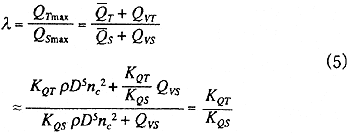QMCR = mean torque at maximum continuous rating

NMCR = rotation speed at maximum continuous rating
NC = resonant rotation speed
QSmax is calculated through torsional vibration analysis and is not to be less than 1.7 times as large as QMCR.5
λ is introduced here as the ratio of QTmax to QSmax (QTmax/QSmax) and will be focused on in the following analysis as a means of determining the peak torque in crash astern condition. λ is generally considered to tend to becoming lager the fuller a ship becomes. It was measured for more than ten ships, and the maximum value from the measured data was found to be 1.6.
3. Determination of λ
In order to examine λ, λ can be expressed as follows in Equation (5).

where
KQS and KQT = torque coefficient at resonant rotation speed in the ahead and astern conditions, respectively (see Figure 4)
ρ = density of sea water (kg/m3)
D = diameter of propeller (m)
nc = resonant rotation speed (rps)
Other symbols are the same as those described in Figure 3.
As can be seen from Equation (5), λ can be approximately expressed as the ratio of KQT to KQS. KQT and KQS are illustrated in Figure 4.
Fig. 4 Illustration showing torque coefficient curve in four quadrants.
J in Figure 4 is the advance coefficient, J = v/Dn, v is the speed of advance of the propeller (taken as approximately the same value as the speed of ship given in Equation (8)), and n is the rotation speed of the propeller per second.
As can be seen from Figure 4, when the propeller rotates astern and the rotation speed is far smaller than nc, the relationship between KQ and J js nearly linear. However, in the steady ahead condition, since the speed of a ship increases as the rotational speed of the propeller increases, J in the vicinity of nc can be considered as not dependant on the individual ship as is the case in the astern condition. Furthermore, KQS in the vicinity of nc in the steady ahead condition does not vary significantly with J. Thus, neglecting variations in KQS, Equation (5) can be rewritten as

Namely, λ can be considered as being approximately proportional to the absolute value of the advance coefficient at the resonant rotation speed of the propeller when the propeller rotates astern.
To discuss JT, a typical measurement of the speed of a ship over time, the rotation speed of the propeller, and the amount of torque in the propeller shaft in the crash astern condition are illustrated in Figure 5 below.
Fig. 5 Illustration showing a time history of ship speed, rotational speed of propeller, and torque of propeller shaft in crash astern condition.
As can be seen from Figure 5, assuming that the resonant rotation speed in the astern condition is the same as that in the steady ahead condition, JT can be expressed in terms of the following Equation (7) by neglecting the effects of wake.
